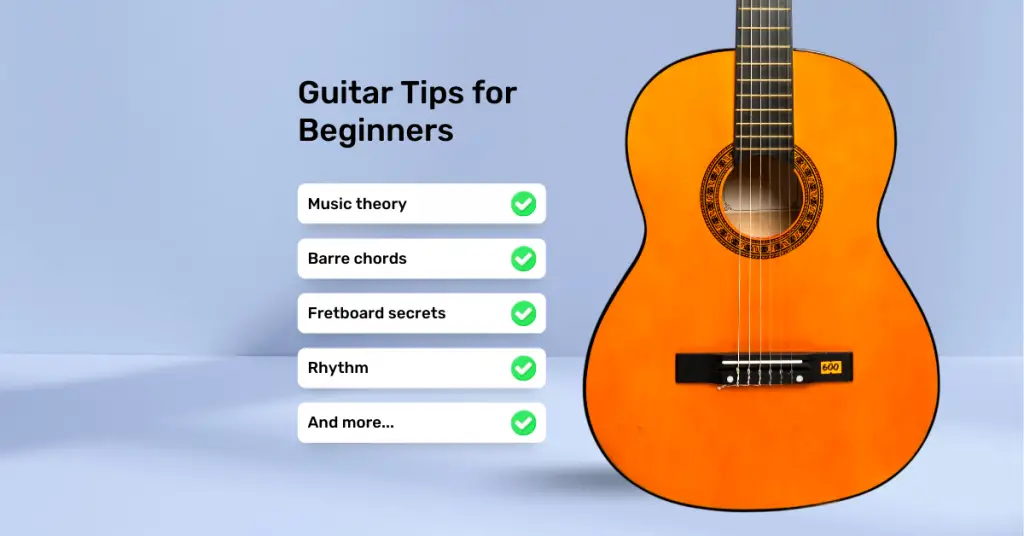What are guitar tabs?
Guitar tabs are an alternative to standard music notation. They notate music for fretted instruments, usually guitar or electric bass, using numbers and symbols.
How to read guitar tabs for beginners
Guitar players need to learn how to read guitar tabs in order to understand and play music.
Guitar tabs are, put simply, read left to right using a system of numbers and symbols, often in conjunction with notation in order to understand the rhythm.
Guitar tab layout and staff
Guitar tabs are layed out using 6 lines that represent the 6 open strings, tuned in standard.
Tablature is often accompanied by a standard music staff. This depicts rhythm and note names, which helps you understand the structure of the song.
Without a depicted rhythm, you’re left with plain notes having no sense of direction.

Basics to know to read guitar tabs
Guitar String Names and Order
Guitar tabs are read from Low E to High E starting from the bottom of the tab chart.
You’ll need to understand the string names in order to see how this works. Don’t worry if you don’t know their names yet, it’s easy to learn!
Here’s a lesson on understanding the string names and order.
What the numbers mean
The numbers on guitar tabs represent frets. 0 means open string, and the rest of the tab numbers correspond with the guitar fret number.
For example, 1 on guitar tab = Fret 1 on that particular string.
Using the example below, play the open string of your Low E, then play frets 1,2, and 3 of your Low E.

Make sure you understand what guitar frets are before you learn how to read guitar tabs.
Understanding guitar tabs
To help you understand how to read these guitar tab symbols better, I’ve written the name of the technique above the staff in each tab example.
Hammer-on
A hammer-on uses what is essentially a downward facing parenthese as its tab symbol. It may also be depicted in text tab with the letter “h”.
A hammer-on leverages the strength of a finger to literally hammer-on to a note, eliminating the need to pick that note.
This is how you get a consistent, flowing sound from one note to the next called legato.

Pull-off
A pull-off uses the same notated tab symbol as a hammer-on, but unlike a hammer-on is depicted with the letters “PO” in text tab.
Pull-offs use the force of a single finger to pull on a string and release to a note already being fretted.
In this example you’d pull-off from frets 7 to 5 using your ring finger on fret 7 and your index finger on fret 5.

Bend
Bends are depicted in guitar tab using upward and downward pointing arrows.
Bending a string moves a note out of pitch, but allows you to stay on the same fret.

Slide
Slides are depicted by slants moving downward to go down in pitch, and moving upward to go higher in pitch.
In the example below, the first group of 2 notes moves down in pitch, and second group of 2 notes moves up in pitch. Pay attention and take note of the different slant used to depict the slides.
Sliding is moving from one fret to another fret with a physical slide on the fretting hand. You have to maintain pressure as you slide in order to hear the note you end the slide on.

Vibrato
Vibrato is depicted by wavy symbols above the tablature.
Vibrato is bending a note in and out of pitch consistently with small, controlled motions.

Tapping
Tapping is depicted by the letter “T” in conjunction with the hammer-on/pull-off tab symbol.
Tapping put simply is a hammer-on performed with a finger, or multiple fingers, from your picking hand.

Palm Muting
Palm muting is generally shown using a P.M above the tablature. The P.M symbol is accompanied by multiple dashes, “P.M—-“, to show greater lengths of muting.
Palm muting is a technique that dampens/ lightly mutes a note. This is done by placing the side of your picking hand on the strings, near the bridge, then picking the note, which results in a deadened sound.

Downstrokes and Upstrokes
Downstrokes and upstrokes are shown in guitar tabs using downward and upward facing arrows.
You’ll follow arrows in the exact direction they face in tabs, with an upward arrow moving towards the high E string, and a downward arrow moving towards the low E string.
Picking downward means picking the string from above, and picking upward means picking the string from underneath.

Common Tabs Symbols Examples PDF
Other Techniques
There’s a plethora of guitar techniques, many of which have their own guitar tab symbols.
However, if a guitar technique does not have a standardized tab symbol, it will generally be specified by the author of the tab. This is usually done with simple text.
What’s next?
Now that you’ve learned how to read guitar tabs, it’s time to put them into practice.
These are lessons on this website that incorporate guitar tabs.
Happy playing!
5 Easy Blues And Rock Guitar Licks
5 Easy Guitar Exercises for Beginners


